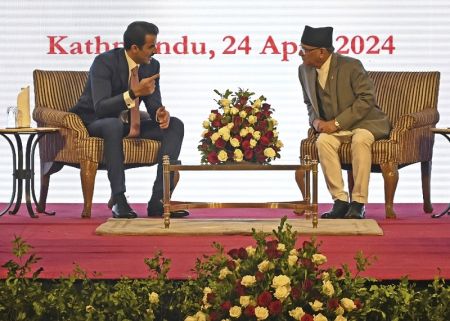By Akhilesh Tripathi
Leaving a few as exceptions, most domestic private sector airlines in Nepal are not in sound financial health. In fact, a majority of them have always been struggling for survival. The list of Nepali private airlines closed down so far is a long one, carrying well over a dozen names of which a few grounded their fleet and downed their shutters after flying in the Nepali sky for as long as a decade. Examples are Necon Air and Cosmic Air. Their contemporaries such as Skyline Air, Shangril-Lai Air, Mountain Air, Nepal Airways, Lumbini Air, Everest Air – to name a few – were also closed down.
Many – five dozen to be exact - haven’t started their operations despite receiving the Airline Operator’s Certificate (AOC) from the Civil Aviation Authority of Nepal (CAAN) many years ago. They are airlines on paper only. Understandably, the biggest deterrent for them is the collapse of several airlines in the past. There is no doubt that the present of the domestic aviation industry has improved, but not enough. A few airlines are really doing well – but they are oonly a few. Others are in the red, according to a highly-placed source at CAAN. Recently, two airlines have been in problems – Agni Air and Guna Air. The latter was acquired by Simirik Air, a helicopter service provider, which rebranded it as Simrik Airlines and launched its domestic flights.
The Number One airline (Buddha Air) at present is far ahead the Number Two (Yeti Airlines) in terms of the number of passengers carried as well as the profit made annually. And there is always a stiff competition among a couple of other private airlines for the Number Three position in the domestic aviation market which has all together 15 private airlines (nine fixed-wing and six rotary-wing) in operation at present. Of the total 1.6 million domestic air passengers in 2012, the Number One airline carried more than 800,000 and also made, according to knowledgeable sources, more than Rs 4 billion in profit. The remaining Rs 3 billion of the annual business was shared by the remaining 14 airlines. That speaks volumes about how profitable some of them might just be!
Ever since the country adopted a liberal aviation policy in 1992, the number of companies seeking and receiving AOC has been rising year on year. However, sustainability has been a major problem for them. “Four of the nine fixed-wing airlines and three of the six rotary-wing airlines operational at present are in profit. Others are in loss,” reveals the CAAN source.
Why?
Why civil aviation is yet to become a profitable business for a majority of the private airlines operational at present? Is the number of airlines more than the market can actually sustain? Why so many airlines have failed? And why do others face the risk of failure? Nubiz sought answers to these questions from four experts of Nepal’s aviation industry: T R Manandhar (Director General of CAAN), Saral Shamser Rana (Deputy Marketing Director of Yeti Airlines), Manoj Karki (Managing Director of Goma Airlines) and Pradeep Shrestha (CEO of Air Kasthamandap). This is how they answered these questions:
‘Airlines should go for mergers’
Yes, it’s true that several airlines have closed down, mainly because of financial reasons, in the past. We have also heard complaints that the number of airlines is more than the market can actually sustain. Therefore, the government has made the Airline Operator’s Certificate Requirements (AOCR) more stringent a couple of months back. Now, no AOC will be issued unless the airline procures the aircraft. Though we have adopted a liberal aviation policy, we don’t encourage companies to enter the aviation industry at the moment, unless they have serious, long-term plans supported by adequate capital base. There are three airlines operating scheduled flights on the trunk routes at present. Two more, Namaste Air and Blue Airways, have applied for scheduled domestic operations on the trunk routes; they are in the process of procuring aircraft.
The main reason why so many domestic airlines collapsed and why many others are incurring a loss is low capital base and lack of long-term planning. Everyone planning an airline company should be clear that it requires huge investments and the operating cost is also very high which means the promoters need deep pockets. The airlines which are operating chartered flights to the remote areas are in loss. That’s why we have started building paved runways at airports in the rural areas. Currently, paved runways are under construction at over half a dozen such airports. Similarly, we are also installing modern aviation tools and technologies such as Tower Console, VOR, CCR, Met equipment, PAPI Light etc at various airports.
I seriously feel that the existing airlines should go for mergers among themselves. This will increase their capital base and fleet and lower the operational cost to some extent. What the experience shows is many airlines collapsed after they faced accidents. So, they must pay proper attention to all the safety measures in order to avoid accidents. There is lack of skilled technical and expert human resource. For example, there is a limited supply of captains and engineers. So, airlines often ‘hunt’ such human resource from among themselves which ultimately affects the operation of those airlines which lose such human resource. The demand of airline service will not increase by any significant degree unless there is a considerable growth in tourist arrivals.
T R Manandhar
Director General
CAAN
‘Only an aviation expert should run an airline’
Very few investors have grasped the aviation business in Nepal properly. An airline cannot be run like most other businesses. Without the experience and knowledge about the costs involved, the turnaround times and expenses that are actually incurred, one will never see a sustainable business. You need an aviation expert to run an aviation business, not just one with the capital to finance it.
The variables in the market, the trends and patterns are unpredictable. A factor such as weather can make or break a season for an airline. Working with the correct promotions team, at the right prices and focusing on the long run is crucial to succeed. The competition is also fierce, and has in the past brought about the closure of various airlines. Seeking opportunities to work together for mutual benefit is rare; rather it’s the opposite and many are out there to bring others down.
The lack of training and experience amongst the teams within the airline is another cause for the downfall. Crew should not be rushed to senior positions just to fill up spaces or to meet some compliance. It is one of the reasons why the accident rate in Nepal is higher than in most places on earth and that directly leads to my next point - insurance premium: loss of one, borne by many. There might be many variable costs in the running of an airline but a primary fixed cost beside the loan is the insurance premium. Whether you fly or not, you always have to pay it. It’s a cost that can bring a company down and it does not take into account a bad season.
The reasons can be endless, however this is not a struggle only faced in Nepal. Richard Branson, founder of Virgin Airlines, on his advice to become a millionaire, said, “The easiest way to become a millionaire is to first become a billionaire and then start an airline!” However, with the backing of investors and good leadership, Nepali aviation can reach greater heights.
Capt Pradeep Shrestha
Chief Executive Officer
Air Kasthamandap
‘Many airlines enter the market without proper market study’
The airlines have to take huge loans from banks as the investment cost is very high. In the past, some companies entered the aviation market only for the sake of it, making the supply higher than the demand. This caused unhealthy competition leading to sustainability problems at the end. The survival of airlines in Nepal is very challenging, especially for those flying to the remote areas where the runways are really bad; other several airport facilities are simply absent. The operating cost is very high. For example, a single servicing of the engine costs around Rs 700,000 to 1 million. Many airlines enter the market without studying the opportunities available.
Airlines flying to the remote areas have additional challenges. The cost of operating flights in the remote areas is comparatively high. The government should fix the number of flights and the rates for remote areas based on the flow of passengers and the operational cost of the flights. The government can help the airlines flying to the rural areas in terms of fuel costs and VAT and other taxes. However, increasing the tourist arrivals is one sure way to make aviation a profitable business for domestic airlines. More tourists means more opportunities for the airlines to make money. The government should make the issuance of AOC more stringent so that there is a balance between demand and supply. Airlines such as Yeti Airlines, Buddha Air, Simrik Air etc seem to have a profitable business. But they have taken huge loans for which the interest is also quite high. However, they have been able to stand out in the market because of proper planning, professional and efficient service, good market strategy, adequate investment and operating capital.
Saral Shamser Rana
Deputy Marketing Director
Yeti Airlines
‘Airlines fail miserably in financial risk management’
The major reason behind the collapse of most domestic airlines in the past is the failure to manage the financial risks. Managerial shortcomings, lack of aircraft matching the country’s geography, lack of enough support from the government and the then aviation policy could be the other reasons. However, it is commendable that the private sector has continued to support the domestic aviation industry despite these odds.
Aircraft matching the country’s difficult geography are a must for an airline. Skilled manpower is another prerequisite. As there is lack of enough skilled human resource, one airline has to often ‘steal’ talents and experienced human resource from the others. The airfares have not increased according to the hike in the aviation fuel prices in recent times. Operating flights in the remote areas entails even higher costs. Hence, profit becomes even more challenging for these airlines. The operating cost of an airline is very high. And it takes at least a few years before an airline can expect profits. So the promoters need to have deep pockets as well as patience and long-term plans before jumping into the market.
Experience has shown that if someone wants to run an airline, then s/he should focus on the airline only. Diverting the income from the airline to other investments may cause problems, especially in the beginning years. We have already seen the fall of several companies which invested the income from aviation into other sectors. The promoters should have enough capital to meet all financial problems that could crop up in the future.
Also, the government needs to revise the aviation policy. The number of passengers has been on a constant rise in flights to the major urban destinations. However, it is difficult for the airlines flying to the rural areas to get enough passengers while the risks of flying are also high in these areas.
Manoj Karki
Managing Director
Goma Air
Nepal’s Civil Aviation: Some Facts
The Nepali private sector entered the domestic air transport after the adoption of Liberal Aviation Policy in 1992. Nepal Airways was the first private airline to start scheduled domestic flights in Nepal (1992). It got the Airline Operator’s Certification from the Civil Aviation Authoruty of Nepal (CAAN) in Feb 1992. Necon Air followed suit in September 1992. In 2001 two other local airlines – Shangri-La Air and Karnali Air merged with Necon which operated flights to all major domestic destinations. It also had flights to Patna and Varanasi in India before being closed down in 2003.
Domestic operation by jet aircraft commenced in 2004 by Cosmic Air. Some 75 private airlines have received AOC from CAAN but only 15 of them are operational at present – nine fixed-wing and 6 rotor-wing airlines. Over a dozen which came into operation after 1992 have closed down so far. Nine fixed-wing airlines operational at present - Nepal Airlines (government-owned), Buddha Air, Yeti Airlines, Sita Air, Tara Air, Air Kasthamandap, Makalu Air, Goma Air, Simrik Airlines (Guna Air has been renamed as Simrik Airlines after it was recently acquired by Simrik Air, a helicopter company) and Agni Air (AOC still valid but flights grounded at present). The domestic civil aviation industry is said to be growing at 10-12 per cent per anum.Private investment in civil aviation is estimated above Rs 11 billion.
Six rotor-wing airlines operational at present are:
- Buddha, Yeti and Simrik are the three airlines operating mountain flights at present.
- NAC, Sita Air and Tara Air are the airlines flying to the rural areas
- Air Kasthamandap launched a test flight to the Syangboche Airport, the highest-altitude airport in Nepal (3780m) on March 18, 2013.
- Air Kasthamandap, Makalu Air and Goma Air, three new players in the aviation market, have single-engine aircraft and don’t have scheduled flights. They operate chartered and cargo flights, mostly to the rural areas.
- Namaste Airlines has applied for permission for domestic flights.























